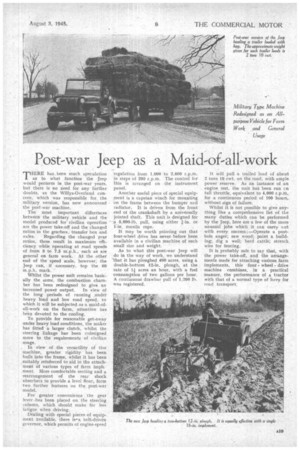Post-war Jeep as a Maid-of-all-work
Page 21

If you've noticed an error in this article please click here to report it so we can fix it.
THERE has, been much speculation as to what function the Jeep would perform in the post-war years, but there is no deed for any further doubts, as the Willys-Overland concern, which was responsible for the military version, has now announced the post-war machine.
The most important differences between the military vehicle and the model produced for civilian operation are the power take-off and the changed ratios in the gearbox,. transfer box and axles. Regarding the changed gear ratios, these result in maximum efficiency while operating at road speeds of from 3 to 7.5 m.p.h., such as are general on farm work. At the other end of the• speed scale, however, the Jeep can, if necessary, top the 60 m.p.h. mark.
Whilst the power unit remains basically the same, the combustion chamber has been redesigned to .give an
increased power output. Tri view of the long periods of running .under heavy load and low road speed, to which it will be subjected as a maid-ofall-work on the farm, attention has be-en devoted to the cooling.
To provide for reasonable get-away under heavy load conditions, the maker has &tied a larger clutch, whilst the steering linkage has been redesigned more to the requirements of civilian usage.
. In view of the versatility of this machine, greater rigidity has been built into the frame, whilst it has been suitably reinforced to aid in the attachment of various types of farm implc ment. More comfortable seating and a rearrangement of the rear shock absorbers to provide a level floor, form two further features on the post-war mode!.
For greater convenience the gear lever -has been placed on the steering column, which should make for less fatigue when driving.
Dealing with special pieces of equipment available, there is^a belt-driven governor, which permits of engine-speed regulation from 1,000 to 2,600 r.p.m. in steps of 200 r.p.m. The control for this is arranged on the instrument panel.
Another useful piece of special equipment is a capstan winch for mounting on the frame between the bumper and radiator. It is driven from the front end of the crankshaft by a universally jointed shaft. This unit is designed for --a 5,000-1h. pull, using either a-in. or 1-in. manila rope.
It may be worth pointing out that four-wheel drive has never before been available in a civilian machine of such small size and weight.
As to what this post-war Jeep will do in the way of work, we understand that it has ploughed 400 acres, using a double-bottom 12-in, plough, at the rate of l acres an hour, with a fuel consumption of two gallons per hour. A continuous drawbar pull of 1,200 lb. was registered. It will pull a trailed load of about 2 tons 10 cwt, on the road, with ample power reserve. As an instance of an engine test, the unit has been run c.n full throttle, equivalent to 4,000 for a continuous period of 100 'hours, without sign of failure.
Whilst it is not possible to give anything like a comprehensive list of the many duties which can be performed by the Jeep, here are a few of the more unusual jobs which it can carry cut with every success:—Operate a posthole auger; saw wood; paint a building; dig a well; herd cattle; stretch wire for fencing.
It is probably safe to say that, with the power take-off, and the arrangements made for attaching various farm implements, this four wheel drive machine combines, in a practical manner, the performance of a tractor with that of a normal type of lorry for road transport.




















































